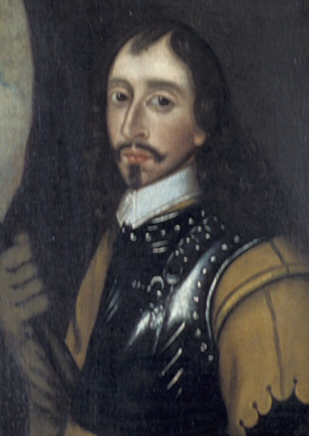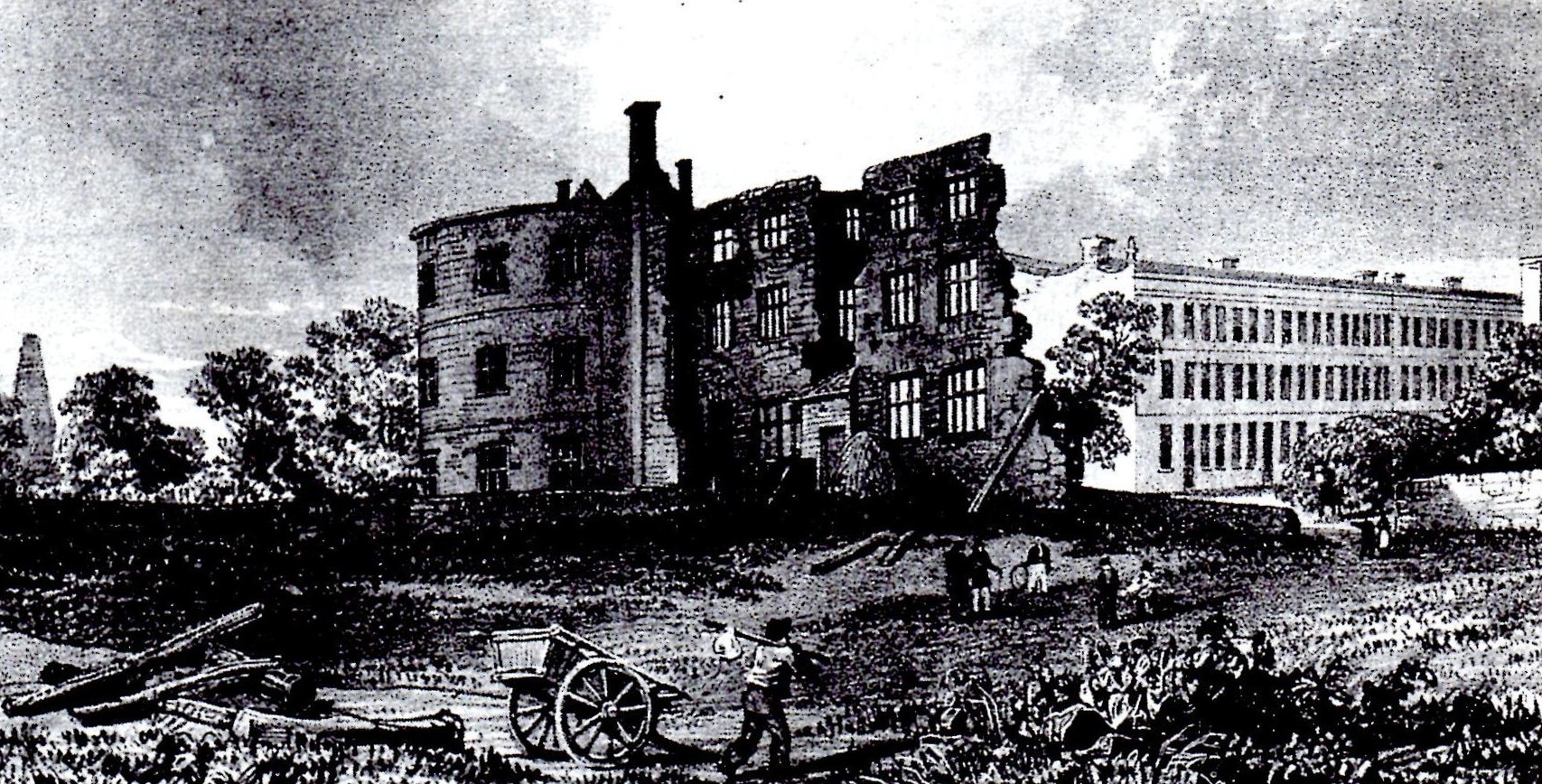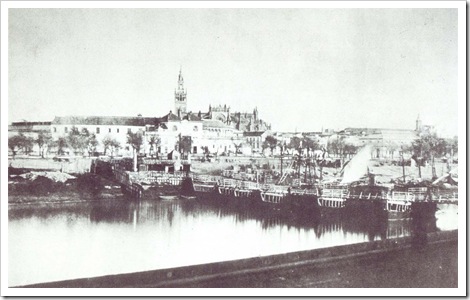|
Siege Of Bridgwater (1645)
The siege of Bridgwater took place in July 1645, during the First English Civil War, when a Royalist garrison surrendered to a Parliamentarian force under Sir Thomas Fairfax. After their victory at Naseby in June, Fairfax and the New Model Army moved into Somerset, where they linked up with the Western Association Army led by Edward Massey. On 10 July, their combined force destroyed the last significant Royalist field army at Langport, clearing the way for an attack on Bridgwater. Siege operations began on 13 July; on 21st, Parliamentarian forces stormed the western part of the town. Many of the buildings were set on fire, and the garrison capitulated on 23 July; over 1,600 prisoners were taken, along with large quantities of weapons and other stores. The capture of Bridgwater meant Parliamentarian forces controlled a line of forts from the Bristol to the English Channels, isolating the Royalist West Country from the rest of England. Fairfax captured Bath and Sherborne, D ... [...More Info...] [...Related Items...] OR: [Wikipedia] [Google] [Baidu] |
Bridgwater Castle
Bridgwater Castle was a castle in the town of Bridgwater, Somerset, England. The stone castle was built around 1220 and contributed to the development of the town. It was surrounded by a moat and included a watergate giving access to the quay. In the 13th and 14th centuries the castle was involved in the Second Barons' War and Despenser War. It then fell into ruin and parts were demolished in the first half of the 17th century and a new house built. Some of the walls survived and it played a minor role in the English Civil War and Monmouth Rebellion. In the later 17th and early 18th centuries many of the remaining buildings were demolished and new residential and industrial buildings constructed, giving its name to Castle Street. The watergate and some sections of wall survive. Early history The castle was built early in the 13th century by William Brewer, like several other castle-builders of the period, an exceptionally wealthy man. He was granted the lordship of the Manor ... [...More Info...] [...Related Items...] OR: [Wikipedia] [Google] [Baidu] |
Bath, Somerset
Bath (Received Pronunciation, RP: , ) is a city in Somerset, England, known for and named after its Roman Baths (Bath), Roman-built baths. At the 2021 census, the population was 94,092. Bath is in the valley of the River Avon, Bristol, River Avon, west of London and southeast of Bristol. The city became a UNESCO World Heritage Site in 1987, and was later added to the transnational World Heritage Site known as the "Great Spa Towns of Europe" in 2021. Bath is also the largest city and settlement in Somerset. The city became a spa with the Latin name ' ("the waters of Sulis") 60 AD when the Romans built Roman Baths (Bath), baths and a temple in the valley of the River Avon, although List of geothermal springs in the United Kingdom, hot springs were known even before then. Bath Abbey was founded in the 7th century and became a religious centre; the building was rebuilt in the 12th and 16th centuries. In the 17th century, claims were made for the curative properties of water ... [...More Info...] [...Related Items...] OR: [Wikipedia] [Google] [Baidu] |
Pontoon Bridge
A pontoon bridge (or ponton bridge), also known as a floating bridge, is a bridge that uses float (nautical), floats or shallow-draft (hull), draft boats to support a continuous deck for pedestrian and vehicle travel. The buoyancy of the supports limits the maximum load that they can carry. Most pontoon bridges are temporary and used in wartime and civil emergencies. There are permanent pontoon bridges in civilian use that can carry highway traffic; generally, the relatively high potential for collapse and sinking (e.g. due to waves and collisions) and high continuous maintenance costs makes pontoons unattractive for most civilian construction. Permanent floating bridges are useful for sheltered water crossings if it is not considered economically feasible to suspend a bridge from anchored Pier (architecture), piers (such as in deep water). Such bridges can require a section that is elevated or can be raised or removed to allow waterborne traffic to pass. Notable permanent pontoo ... [...More Info...] [...Related Items...] OR: [Wikipedia] [Google] [Baidu] |
Devon
Devon ( ; historically also known as Devonshire , ) is a ceremonial county in South West England. It is bordered by the Bristol Channel to the north, Somerset and Dorset to the east, the English Channel to the south, and Cornwall to the west. The city of Plymouth is the largest settlement, and the city of Exeter is the county town. The county has an area of and a population of 1,194,166. The largest settlements after Plymouth (264,695) are the city of Exeter (130,709) and the Seaside resort, seaside resorts of Torquay and Paignton, which have a combined population of 115,410. They all are located along the south coast, which is the most populous part of the county; Barnstaple (31,275) and Tiverton, Devon, Tiverton (22,291) are the largest towns in the north and centre respectively. For local government purposes Devon comprises a non-metropolitan county, with eight districts, and the Unitary authorities of England, unitary authority areas of Plymouth City Council, Plymouth an ... [...More Info...] [...Related Items...] OR: [Wikipedia] [Google] [Baidu] |
Bridgwater Bay
Bridgwater Bay is on the Bristol Channel, north of Bridgwater in Somerset, England at the mouth of the River Parrett and the end of the River Parrett Trail. It stretches from Minehead at the southwestern end of the bay to Brean Down in the north. The area consists of large areas of mudflats, saltmarsh, sandflats and shingle ridges, some of which are vegetated. It has been designated as a Site of Special Scientific Interest (SSSI) covering an area of since 1989, and is designated as a wetland of international importance under the Ramsar Convention. The risks to wildlife are highlighted in the local Oil Spill Contingency Plan. Several rivers, including the Parrett, Brue and Washford, drain into the bay. Man-made drainage ditches from the Somerset Levels, including the River Huntspill, also run into the bay. The mud flats provide a habitat for a wide range of flora and fauna. These include some nationally rare plants, beetles and snails. It is particularly important for over ... [...More Info...] [...Related Items...] OR: [Wikipedia] [Google] [Baidu] |
River Parrett
The River Parrett is a river that flows through the counties of Dorset and Somerset in South West England, from its source in the Thorney Mills springs in the hills around Chedington in Dorset. Flowing northwest through Somerset and the Somerset Levels to its mouth at Burnham-on-Sea, into the Bridgwater Bay nature reserve on the Bristol Channel, the Parrett and its tributaries drain an area of – about 50 per cent of Somerset's land area, with a population of 300,000. The Parrett's main tributaries include the Rivers Tone, Isle, and Yeo, and the River Cary via the King's Sedgemoor Drain. The long river is tidal for up to Oath. Between Langport and Bridgwater, the river falls only , so it is prone to frequent flooding in winter and during high tides. Many approaches have been tried since at least the medieval period to reduce the incidence and effect of floods and to drain the surrounding fields. In Anglo-Saxon times, the river formed a boundary between ... [...More Info...] [...Related Items...] OR: [Wikipedia] [Google] [Baidu] |
Edward Massie
Sir Edward Massey, also spelt Massie, () was an English soldier and politician from Cheshire, who sat in the House of Commons at various times between 1646 and 1674. He fought for Parliament in the First English Civil War, when he became famous for his defence of Gloucester. Although he remained loyal during the 1648 Second English Civil War, Massey switched sides following the Execution of Charles I in January 1649, and served under his son Charles II during the Anglo-Scottish war (1650–1652). Badly wounded at Worcester in September 1651, he was captured but managed to escape, and rejoin the exiled Stuart court in the Dutch Republic. During the Interregnum, he was active in the Royalist cause, and in 1659 took part in Booth's Uprising, centred on his home county of Cheshire. After the Stuart Restoration in May 1660, he was knighted and sat as MP for Gloucester until his death. Appointed to the Privy Council of Ireland in 1661, he spent much of his time on his estate at Abb ... [...More Info...] [...Related Items...] OR: [Wikipedia] [Google] [Baidu] |
Manor Of Sydenham
Sydenham House, the manor house of the ancient manor of Sydenham in the parish of Wembdon, Somerset, England, is a Listed building, grade II listed building, constructed in the early 16th century and refronted and rebuilt after 1613. In 1937, British Cellophane Ltd set up production and built extensive factories on of land ("Sydenham Manor Fields") adjacent to the manor house. Production ceased in 2005 and between 2010 and 2015 the industrial site was razed to the ground. In 2015 the razed site is owned by EDF Energy, which in 2012 purchased the manor house with the former factory site, intended for construction of temporary accommodation for 1,000 workers. History In 1381 Sydenham House was sacked by Bridgwater's peasants under Nicholas Frampton during the Peasants' Revolt of 1381. The local tax collectors were murdered and the town's records were destroyed. Its owners were on the losing side in the English Civil War, Civil War and again in the Monmouth Rebellion. The curre ... [...More Info...] [...Related Items...] OR: [Wikipedia] [Google] [Baidu] |
Clubmen
Clubmen were bands of local defence vigilantes during the English Civil War (1642–1651) who tried to protect their localities against the excesses of the armies of both sides in the war. They sought to join together to prevent their wives and daughters being raped by soldiers of both sides, themselves being forcibly conscripted to fight by one side or the other, their crops and property being damaged or seized by the armies and their lives threatened or intimidated by soldiers, battle followers, looters, deserters or refugees. As their name suggests, they were mostly armed with cudgels, flails, scythes and sickles fastened to long poles. They were otherwise unarmed. Initially Clubmen gatherings came together spontaneously in response to the actions of soldiers in their localities but as the war went on Clubmen in some areas were organised by the local gentry and churchmen and were a force which both sides in the war had to take into account when planning a campaign and garriso ... [...More Info...] [...Related Items...] OR: [Wikipedia] [Google] [Baidu] |
Sieges Of Taunton
The sieges of Taunton were a series of three blockades during the First English Civil War. The town of Taunton, in Somerset, was considered to be of strategic importance because it controlled the main road from Bristol to Devon and Cornwall. Robert Blake commanded the town's Parliamentarian defences during all three sieges, from September 1644 to July 1645. The first siege was laid by Edmund Wyndham on 23 September, and was primarily composed of Royalist troops from local Somerset garrisons. After initial assaults drove Blake and his troops back into Taunton Castle, the blockade was conducted from away, and concentrated more on starving the garrison than continued attacks. The town was relieved by a force under James Holborne on 14 December. Over the next three months, Blake was able to establish a network of earthen defences in Taunton, including a basic perimeter and several forts. The Royalists began the second, and bloodiest, siege in late March 1645, initially under S ... [...More Info...] [...Related Items...] OR: [Wikipedia] [Google] [Baidu] |
George Goring, Lord Goring
George Goring, Lord Goring (14 July 1608 – 1657) was an English Cavalier, Royalist soldier. He was known by the Courtesy titles in the United Kingdom, courtesy title ''Lord Goring'' as the eldest son of the George Goring, 1st Earl of Norwich, first Earl of Norwich. Early life Goring, the eldest son of George Goring, 1st Earl of Norwich, was born on 14 July 1608. He married Lettice Boyle, the daughter of Richard Boyle, 1st Earl of Cork. Experience before the Civil Wars His father-in-law, Richard Boyle, 1st Earl of Cork, procured for him a post in the Royal Netherlands Army#1572 to 1814, Dutch Army with the rank of colonel. He was permanently lamed by a wound received at the Siege of Breda (1637), Siege of Breda in 1637, and returned to England early in 1639, when he was made governor of Portsmouth. He served in the Bishops' Wars, and already had a considerable reputation when he was involved in the "First Army Plot, Army Plot" (1641). Officers of the army stationed at Y ... [...More Info...] [...Related Items...] OR: [Wikipedia] [Google] [Baidu] |
Prince Rupert Of The Rhine
Prince Rupert of the Rhine, Duke of Cumberland, (17 December 1619 ( O.S.) 7 December 1619 (N.S.)– 29 November 1682 (O.S.) December 1682 (N.S) was an English-German army officer, admiral, scientist, and colonial governor. He first rose to prominence as a Royalist cavalry commander during the English Civil War. Rupert was the third son of the German Prince Frederick V of the Palatinate and Elizabeth, eldest daughter of King James VI and I of England and Scotland. Prince Rupert had a varied career. He was a soldier as a child, fighting alongside Dutch forces against Habsburg Spain during the Eighty Years' War (1568–1648), and against the Holy Roman Emperor in Germany during the Thirty Years' War (1618–1648). Aged 23, he was appointed commander of the Royalist cavalry during the English Civil War, becoming the archetypal "Cavalier" of the war and ultimately the senior Royalist general. He surrendered after the fall of Bristol and was banished from England. He serv ... [...More Info...] [...Related Items...] OR: [Wikipedia] [Google] [Baidu] |







